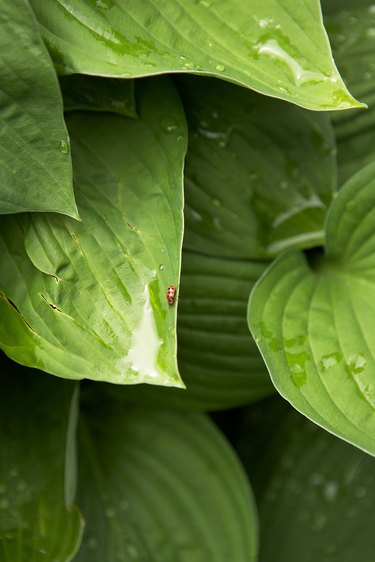
Hostas (Hosta spp.) are widely cultivated as herbaceous perennials primarily for their attractive foliage, shade tolerance and spikes of flowers. These plants are grown as herbaceous perennials across U.S. Department of Agriculture plant hardiness zones 3 through 9, although individual species may offer a narrower potential growing range. Some hosta cultivars feature leaves that normally have white or yellow and green variegation. Unusual or unexpected white spots or areas on a hosta plant may warrant concern, close inspection and corrective action.
Anthracnose
Video of the Day
Anthracnose is a fungal disease that appears on infected hostas as irregular white or tan leaf spots typically bordered by brown tissue. The centers of these leaf spots often fall out and hosta foliage becomes tattered. Warm, wet weather encourages anthracnose spread. To avoid problems with this disease and other fungal leaf spots, space hosta plants well to encourage good air circulation, avoid splashing water on the foliage, and remove and dispose of infected leaves promptly.
Video of the Day
Viruses
Multiple viruses may impact hostas, disrupting normal cell growth. Viruses are transmitted by feeding insects, through the propagation of infected plants and on unsterilized tools. Symptoms range between viruses, but often include white or off-white mottling, rings or patterns on foliage. Viruses potentially impacting hostas include the impatiens necrotic spot virus, tomato ringspot virus and hosta virus X. Where multiple viruses are present on a single plant, it can make it more difficult to diagnose the problem. To avoid problems with viruses, carefully inspect all plants prior to bringing them into the landscape and obtain hostas only from reputable sources. Remove and dispose of infected hostas to avoid disease spread and keep nearby areas free of weeds, which can also host viruses.
Sunscald
Hostas perform best in a lightly shaded site, or a spot that receives morning sun and afternoon shade, although some hosta cultivars are exceptions. Excessive sunlight causes exposed leaves to develop a bleached white or yellow color. These spots often become thin or papery and tan. Entire leaves can die. Remove dead leaves to improve the plant's appearance and consider relocating the hosta to a shadier spot or implementing a larger, shading plant nearby to create a more suitable environment for the hosta. Excessive wind or drought conditions can cause symptoms similar to sunscald.
Additional Problems
Petiole rot, caused by Sclerotium rolfsii, forces hosta leaves to turn yellow, then brown, before wilting and collapsing. A white, cottony growth will develop at the base of the infected hosta and in the surrounding soil. Foliar nematodes cause a pale yellow or tan stripe between leaf veins. These pests tend to attack lower leaves first and are most problematic in late summer. Damage to hosta roots or stems can cause leaf bleaching or browning similar to sunscald and drought stress.